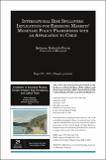Artículo
International risk spillovers: implications for emerging markets’ monetary policy frameworks with an application to Chile
Date
2023-08-09Abstract
Among the factors behind international spillovers, U.S. monetary policy developments retain a major influence. Such developments
drive the global financial cycle as strongly demonstrated by Rey (2013), Miranda-Agrippino and Rey (2020), Miranda-Agrippino and
Rey (2021). The dramatic U.S. monetary easing during the early months of the Covid-19 pandemic was the single most important
factor for the reversal of capital outflows to emerging markets and developing economies.1 As shown by Kalemli-Özcan (2019), the
transmission mechanism for monetary policy spillovers to emerging market economies (EMEs) rests on the effect of U.S. monetary policy on investors’ risk sentiments, as those sentiments are more volatile in the case of EMEs. In Kalemli-Özcan (2019), I show that capital flows to emerging markets are particularly “risk-sensitive.” This creates a challenge unique to the EME policymakers and their monetary policy frameworks.
Collections
View/

The following license files are associated with this item:

